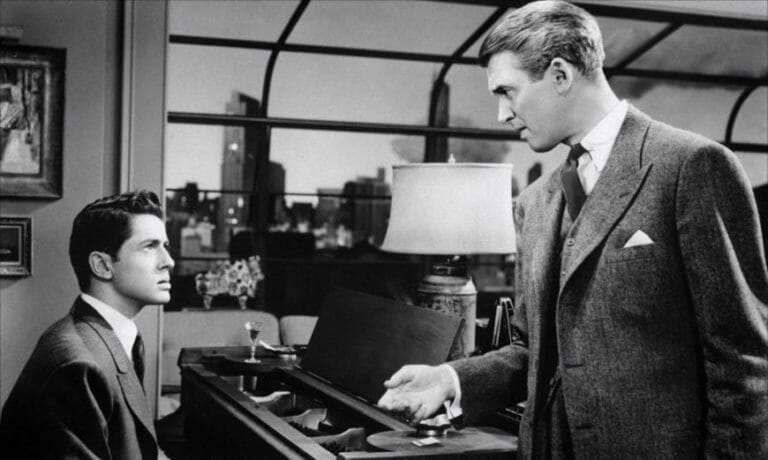Sign up for the
TSL Newsletter
and get $50 off Final Draft 12
By Matthew Pizana · December 6, 2014

Murder is often the theme that many of Alfred Hitchcock’s greatest films revolve around. He loved to play with the audience through tension and suspense, waiting as the characters got closer to exposing the killer. Rope is an exploration into the mind of two intellectuals who use their smarts to try and get away with the perfect murder.
Brandon Shaw (John Dall) and Phillip Morgan (Farley Granger) are college intellectuals always looking for some way to show off their superior brain power. To test out their smarts, the duo kills a former classmate to prove they can commit the perfect murder. They hide the body in a large antique chest in their apartment and set about getting ready for the dinner party they will host later in the evening. The guest list includes their classmates’ father and aunt as well as their former housemaster Rupert (James Stewart). The spark of the idea for the murder originated with their Rupert who often spoke in class of murder as a way to show superiority over others. As the evening progresses, Brandon prods Rupert to speak more about his views on the superiority of murder. Brandon continues to bring up the absence of his classmate causing the father and aunt to become more worried about his whereabouts eventually leading to everyone at the party to leave. Rupert ends up coming back to the house where he begins to converse with the boys until the pressure and drinking finally get to Phillip and he snaps allowing Rupert to discover the body in the chest.
As if murder isn’t enough to get away with, Brandon constantly adds obstacles to the situation to overcome. He sets up the entire dinner party feast on top of the chest in the living room so the guests must constantly circle around the body. He wraps books for Mr. Kentley with the same rope he used to kill his son. His arrogance knows no bounds. What good is a murder if someone else, especially someone else who would hold such a feat in high regards, didn’t know you did it? He constantly pushes Rupert to poetically wax his thoughts about the superiority of murder which in the end leads to his undoing.
As a filmmaker, Hitchcock pushed the boundaries of cinema and storytelling while making Rope. In order to get the feel of the play the movie is based on, he would shoot the entire ten minutes of film stock for every take. This allowed him to limit the number of cuts and edits in the film, keeping the illusion of everything happening in real time. This ensures that the audience would believe the body remained in the chest for the entirety of the story. He also made the choice to keep the two main characters as a gay couple. This caused the movie to be banned in some cities as audiences in the 40’s were not so accustomed to seeing this relationship on screen.
Alfred Hitchcock locked Rope away in a vault for many decades, hiding it from viewers' eyes because he felt that it was an experiment that didn’t quite work out. Despite this trepidation, the director took several lessons he learned while filming with him throughout the rest of his illustrious career. Also of note is the performance by James Stewart. This was the actor’s first time working with the great director and his portrayal of a man watching from the outside piecing together the puzzle became a precursor for his role in Hitchcock’s Rear Window. Hitchcock showed with Rope that a good filmmaker can suspend disbelief. A master director can change perception.